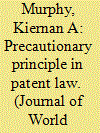| Srl | Item |
| 1 |
ID:
088911


|
|
|
|
|
| Publication |
2009.
|
| Summary/Abstract |
The rising importance of Chinese herbal medicine (CHM) in alleviating human suffering has created a potential niche for East Asian countries in the profitable global pharmaceutical market. However, modern CHM that involves modern biomedical technologies presents new issues regarding the proper degree and methods of protection that apply to these products or inventions. Pharmaceutical industries most commonly seek patent protection, which offers different types of protections for different types of inventions. This article explores whether product-by-process patent claims provide proper protection to CHM product inventions and the likely implications of such an approach. It concludes that product-by-process patent claims may offer proper protection for CHM product inventions at the current status quo but might be an inadequate approach when the industry matures in the future.
|
|
|
|
|
|
|
|
|
|
|
|
|
|
|
|
| 2 |
ID:
097011


|
|
|
|
|
| Publication |
2010.
|
| Summary/Abstract |
The potential of human embryonic stem cell (ESC) research could prove to provide immense therapeutic value for illnesses not curable under currently existing therapies. However, human ESC research is controversial as it touches the fundamental value of human life. Taiwan has been aiming to become the biotech hub of Asia-Pacific and is becoming a major player in human ESC research. Whether or not the research results from human ESC are patentable could have a profound impact on the progress in this field. In this article, the science of human ESC research is clarified and tested against the existing murky Taiwan patent standards. In particular, this article distinguishes between therapeutic cloning and reproductive cloning techniques, asks questions about the patentability of totipotent human ESCs and explores the meaning of the word embryo. This article draws comparison with the European practice on ethical standards and concludes that patenting human ESC research might not be so controversial, but Taiwan has to make its patent law clearer in this field to fulfill the country's intended goal.
|
|
|
|
|
|
|
|
|
|
|
|
|
|
|
|
| 3 |
ID:
092463


|
|
|
|
|
| Publication |
2009.
|
| Summary/Abstract |
The precautionary principle (PP) has rapidly emerged as a staple of international environmental law and attempts have been made to extend it into other fields. This article examines whether the PP can or should be extended into patent law. First, an assessment of the general arguments in favour of extending the PP into patent law is performed, followed by an analysis of its applicability within Canadian patent law as it is currently enacted. Then, the arguments against a precautionary patent law are scrutinized.
|
|
|
|
|
|
|
|
|
|
|
|
|
|
|
|